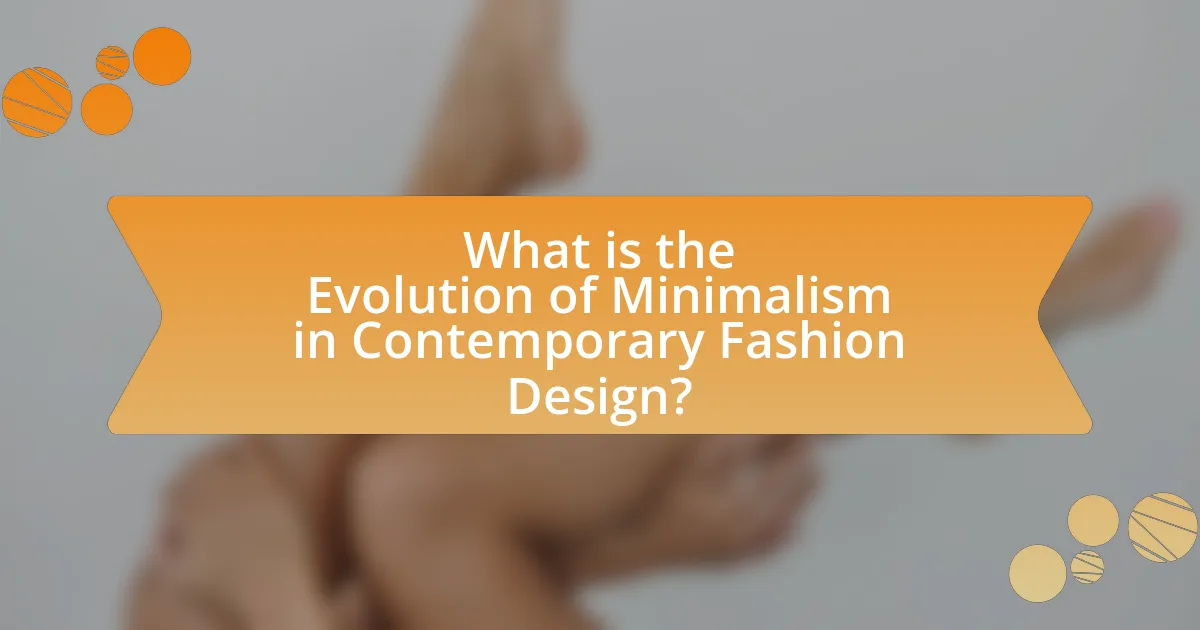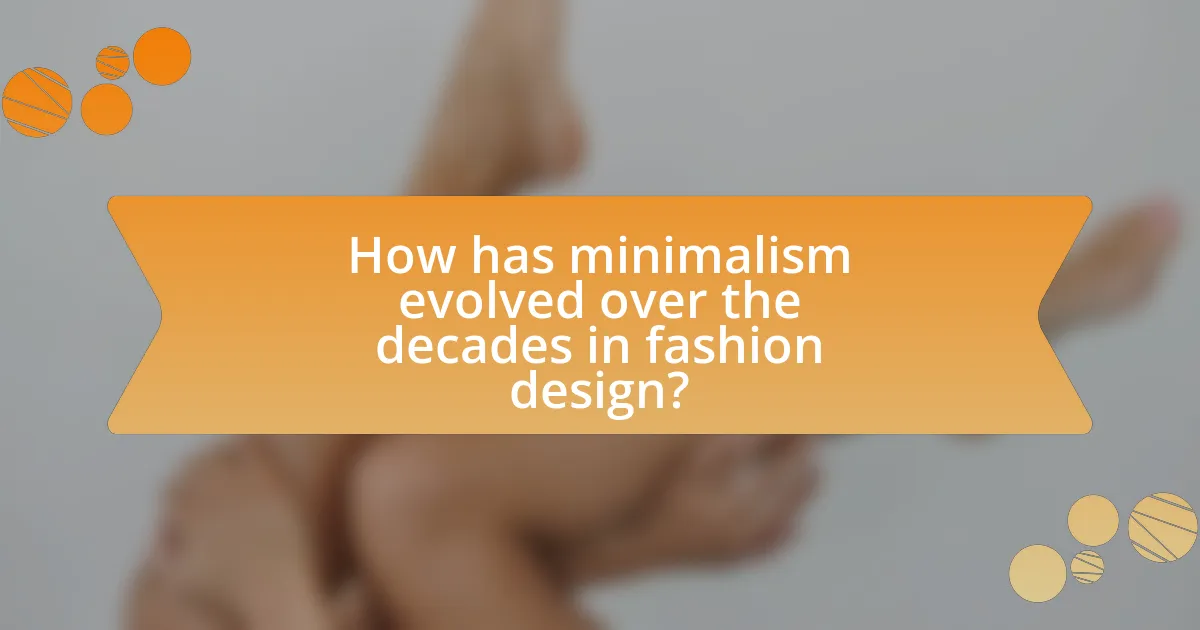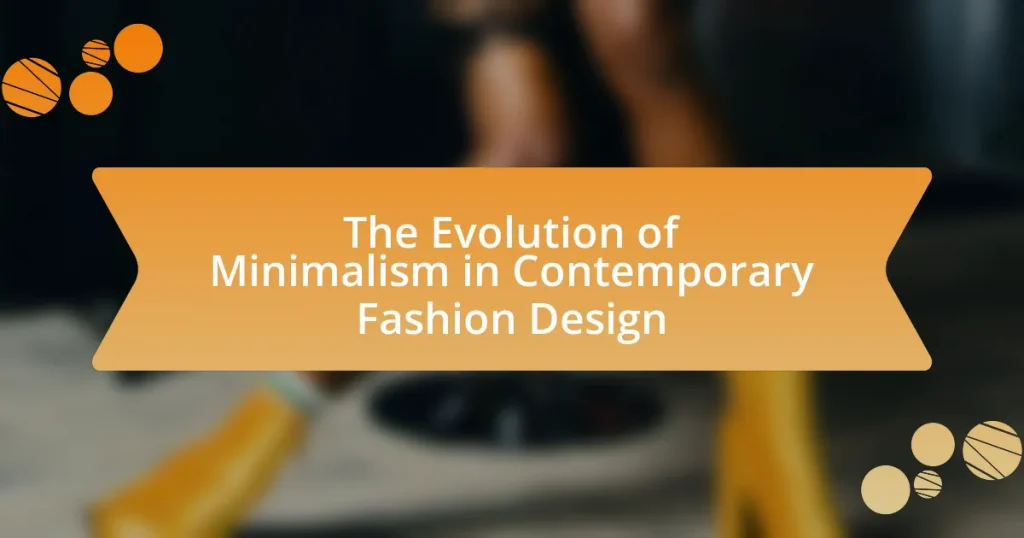The article examines the evolution of minimalism in contemporary fashion design, highlighting its origins in the 1960s and 1970s as a response to excess in fashion. It discusses key designers such as Jil Sander and Calvin Klein who popularized minimalist aesthetics characterized by clean lines, neutral colors, and a focus on quality materials. The article also explores the impact of cultural and economic shifts on minimalism, its relevance in today’s sustainable fashion landscape, and the challenges it faces from fast fashion. Additionally, it outlines practical tips for incorporating minimalism into personal style and building a minimalist wardrobe.

What is the Evolution of Minimalism in Contemporary Fashion Design?
The evolution of minimalism in contemporary fashion design reflects a shift towards simplicity, functionality, and a focus on essential forms. Originating in the 1960s and 1970s as a reaction against the excesses of previous fashion trends, minimalism emphasizes clean lines, neutral colors, and a reduction of ornamentation. Designers such as Jil Sander and Calvin Klein played pivotal roles in popularizing this aesthetic, showcasing collections that prioritize quality materials and craftsmanship over flamboyant designs. The rise of sustainable fashion in the 21st century further propelled minimalism, as consumers increasingly seek timeless pieces that reduce waste and promote longevity. This evolution is evidenced by the growing prominence of brands that embody minimalist principles, such as Everlane and COS, which focus on transparency and ethical production while maintaining a sleek, understated style.
How did minimalism emerge as a significant trend in fashion design?
Minimalism emerged as a significant trend in fashion design during the late 20th century, primarily influenced by the broader minimalist art movement that began in the 1960s. Designers like Calvin Klein and Jil Sander championed simplicity, focusing on clean lines, neutral colors, and functional silhouettes, which contrasted sharply with the excesses of previous fashion trends. This shift was further propelled by cultural changes, including a growing consumer desire for sustainability and authenticity, leading to a preference for timeless, versatile pieces over fast fashion. The minimalist aesthetic resonated with the ethos of the time, emphasizing quality over quantity and reflecting a lifestyle choice that prioritized simplicity and clarity.
What historical events influenced the rise of minimalism in fashion?
The rise of minimalism in fashion was significantly influenced by the cultural and economic shifts of the late 20th century, particularly the 1960s and 1970s. During this period, the counterculture movement and the rejection of excess in consumerism led to a preference for simplicity and functionality in clothing. The 1970s saw the emergence of designers like Calvin Klein and Jil Sander, who emphasized clean lines and understated aesthetics, reflecting a broader societal desire for authenticity and practicality. Additionally, the economic downturns of the 1980s prompted a shift away from opulence towards more sustainable and timeless fashion choices, further solidifying minimalism’s place in contemporary design.
How did key designers contribute to the minimalist movement?
Key designers significantly shaped the minimalist movement by emphasizing simplicity, functionality, and clean lines in their work. For instance, designers like Rei Kawakubo and Yohji Yamamoto challenged traditional fashion norms by creating garments that stripped away excess, focusing instead on form and silhouette. Their collections often featured monochromatic palettes and innovative cuts, which became hallmarks of minimalist design. Additionally, the work of Jil Sander and Calvin Klein popularized minimalist aesthetics in mainstream fashion, showcasing how less can be more through their streamlined designs and emphasis on quality materials. These contributions collectively established minimalism as a defining style in contemporary fashion, influencing both high fashion and everyday wear.
What are the defining characteristics of minimalist fashion design?
Minimalist fashion design is characterized by simplicity, functionality, and a focus on essential elements. This design approach emphasizes clean lines, neutral color palettes, and a lack of excessive ornamentation, allowing the quality of materials and craftsmanship to take center stage. Historical context shows that minimalist fashion gained prominence in the late 20th century, influenced by movements such as Bauhaus and Japanese aesthetics, which prioritize form and function over embellishment. The effectiveness of minimalist design is evident in its ability to create timeless pieces that transcend trends, as seen in the works of designers like Jil Sander and Calvin Klein, who have consistently embraced these principles in their collections.
How does simplicity manifest in minimalist clothing?
Simplicity in minimalist clothing manifests through clean lines, neutral color palettes, and a focus on functionality. This design approach emphasizes essential shapes and avoids excessive embellishments, allowing garments to serve their purpose without distraction. For instance, brands like COS and Everlane exemplify this by offering pieces that prioritize quality materials and timeless silhouettes, which contribute to a streamlined aesthetic. The minimalist philosophy is rooted in the idea that less is more, promoting a wardrobe that is both versatile and sustainable, as seen in the growing trend of capsule wardrobes that encourage mindful consumption.
What role do colors and materials play in minimalist fashion?
Colors and materials are fundamental in minimalist fashion as they establish the aesthetic and functional essence of the style. Minimalist fashion typically employs a limited color palette, often featuring neutral tones such as black, white, gray, and earth tones, which promote simplicity and versatility in clothing choices. This restrained use of color allows for easy mixing and matching, enhancing the wearer’s ability to create a cohesive wardrobe with fewer pieces.
Materials in minimalist fashion are chosen for their quality and texture, emphasizing natural fibers like cotton, linen, and wool, which contribute to a timeless and sustainable approach. The focus on high-quality materials ensures durability and comfort, aligning with the minimalist ethos of valuing longevity over fast fashion. For instance, a study by the Fashion Institute of Technology highlights that the choice of materials significantly impacts consumer perceptions of quality and sustainability in fashion, reinforcing the minimalist commitment to thoughtful consumption.
Why is minimalism relevant in contemporary fashion?
Minimalism is relevant in contemporary fashion because it emphasizes simplicity, functionality, and sustainability, aligning with current consumer values. This design philosophy responds to the fast fashion industry’s excesses by promoting timeless pieces that reduce waste and encourage mindful consumption. Research indicates that 66% of consumers are willing to pay more for sustainable brands, highlighting a shift towards minimalism as a preferred choice in fashion.
How does minimalism address sustainability in fashion design?
Minimalism addresses sustainability in fashion design by promoting the creation of fewer, high-quality garments that prioritize durability and timelessness over fast fashion trends. This approach reduces waste and resource consumption, as minimalist designs often emphasize versatile pieces that can be worn in multiple ways and for various occasions. Research indicates that the fashion industry is responsible for 10% of global carbon emissions, and by adopting minimalist principles, brands can significantly lower their environmental impact. For example, brands like Everlane and COS focus on transparency and ethical production, aligning with minimalist values to foster sustainable practices in their collections.
What cultural shifts have reinforced the appeal of minimalism?
Cultural shifts such as the rise of environmental consciousness, the digital nomad lifestyle, and the backlash against consumerism have reinforced the appeal of minimalism. Increased awareness of sustainability has led individuals to prioritize quality over quantity, favoring minimalist designs that reduce waste and promote longevity. The digital nomad trend encourages a lifestyle that values mobility and simplicity, making minimalism an attractive choice for those seeking to travel light. Additionally, a growing discontent with materialism and fast fashion has prompted consumers to embrace minimalism as a means of achieving a more meaningful and intentional life. These shifts collectively validate minimalism as a relevant and appealing lifestyle choice in contemporary society.

How has minimalism evolved over the decades in fashion design?
Minimalism in fashion design has evolved significantly from the 1960s to the present day, transitioning from a radical movement to a mainstream aesthetic. In the 1960s, designers like Yves Saint Laurent and Pierre Cardin embraced clean lines and simple silhouettes, reflecting a cultural shift towards modernity. The 1980s saw minimalism gain traction with designers such as Calvin Klein and Jil Sander, who emphasized functionality and understated elegance, often using neutral color palettes and high-quality fabrics.
By the 1990s, minimalism became synonymous with luxury, as brands like Helmut Lang and Ann Demeulemeester showcased the concept through innovative tailoring and a focus on craftsmanship. In the 2000s, the rise of fast fashion introduced a new challenge, prompting minimalist designers to adapt by incorporating sustainable practices and ethical production methods. Today, minimalism continues to influence contemporary fashion, with a renewed emphasis on sustainability and timeless design, as seen in the collections of brands like COS and Everlane. This evolution reflects broader societal values, including a desire for simplicity and environmental consciousness in consumer choices.
What were the key phases in the evolution of minimalist fashion?
The key phases in the evolution of minimalist fashion include the emergence of modernism in the early 20th century, the rise of Japanese designers in the 1980s, and the resurgence of minimalism in the 2010s. Modernism introduced clean lines and functional designs, with influential figures like Coco Chanel and Yves Saint Laurent promoting simplicity. In the 1980s, Japanese designers such as Issey Miyake and Rei Kawakubo challenged Western fashion norms, emphasizing asymmetry and innovative materials while maintaining a minimalist aesthetic. The 2010s saw a revival of minimalist fashion, driven by brands like The Row and COS, focusing on sustainability and timeless pieces, reflecting a shift towards conscious consumerism. These phases collectively illustrate the ongoing evolution and relevance of minimalist fashion in contemporary design.
How did the 1990s define minimalist aesthetics in fashion?
The 1990s defined minimalist aesthetics in fashion through a focus on simplicity, clean lines, and a neutral color palette. Designers such as Calvin Klein and Jil Sander emphasized understated elegance, moving away from the excesses of the 1980s. This era saw the rise of garments that prioritized functionality and versatility, often featuring unembellished silhouettes and high-quality fabrics. The minimalist trend was further validated by the popularity of brands like Helmut Lang, which showcased a refined approach to everyday wear, emphasizing the idea that less is more. This shift in fashion not only influenced clothing design but also reflected broader cultural movements towards simplicity and authenticity in lifestyle choices during the decade.
What changes occurred in the 2000s that impacted minimalist design?
In the 2000s, the rise of digital technology and the internet significantly impacted minimalist design by promoting simplicity and functionality in both fashion and user interfaces. The proliferation of online shopping and digital media encouraged brands to adopt clean lines and uncluttered aesthetics to enhance user experience and accessibility. Additionally, the minimalist movement gained traction through influential designers like Jil Sander and brands such as COS, which emphasized essentialism and quality over excess. This shift was further supported by cultural trends that favored sustainability and ethical consumption, leading to a preference for timeless, versatile pieces over fast fashion.
How have contemporary designers interpreted minimalism?
Contemporary designers have interpreted minimalism by emphasizing simplicity, functionality, and a focus on essential forms. This interpretation often manifests in the use of clean lines, neutral color palettes, and the elimination of unnecessary embellishments, aligning with the principles established by early minimalist movements. For instance, designers like Jil Sander and Calvin Klein have created collections that prioritize streamlined silhouettes and high-quality materials, reflecting a commitment to craftsmanship while maintaining a restrained aesthetic. This approach not only enhances the wearability of garments but also resonates with a growing consumer preference for sustainable and timeless fashion, as evidenced by the increasing popularity of capsule wardrobes that embody minimalist principles.
What innovative techniques are being used in modern minimalist fashion?
Modern minimalist fashion employs innovative techniques such as zero-waste pattern making, digital fabrication, and sustainable materials sourcing. Zero-waste pattern making minimizes fabric waste by designing garments that utilize the entire fabric piece, which is increasingly adopted by brands like Reformation. Digital fabrication, including 3D printing, allows for precise and customizable designs, exemplified by companies like Unfold, which create intricate structures with minimal material. Additionally, the use of sustainable materials, such as organic cotton and recycled polyester, is prevalent, as seen in the collections of brands like Everlane, which prioritize eco-friendly practices. These techniques reflect a commitment to sustainability and efficiency in contemporary minimalist fashion.
How do contemporary minimalist collections differ from earlier designs?
Contemporary minimalist collections differ from earlier designs primarily in their emphasis on sustainability and technology. While earlier minimalist designs focused on simplicity and functionality, contemporary collections integrate eco-friendly materials and innovative production techniques, reflecting a growing awareness of environmental issues. For instance, brands like Stella McCartney utilize sustainable fabrics and ethical manufacturing processes, which were not prevalent in earlier minimalist fashion. This shift not only enhances the aesthetic appeal but also aligns with modern consumer values, making contemporary minimalist collections more relevant in today’s market.

What impact has minimalism had on the fashion industry?
Minimalism has significantly influenced the fashion industry by promoting simplicity, sustainability, and timeless design. This movement encourages brands to focus on essential pieces, reducing excess and fostering a more thoughtful approach to consumption. For instance, the rise of capsule wardrobes exemplifies this trend, where consumers invest in a limited number of versatile items that can be mixed and matched, thereby minimizing waste. Additionally, brands like Everlane and COS have embraced minimalist aesthetics, emphasizing transparency in production and ethical sourcing, which aligns with consumer demand for responsible fashion. This shift has led to a broader cultural conversation about the value of quality over quantity in clothing, reshaping consumer behavior and industry practices.
How has minimalism influenced consumer behavior in fashion?
Minimalism has significantly influenced consumer behavior in fashion by promoting a preference for simplicity and quality over quantity. This shift has led consumers to prioritize timeless pieces and sustainable practices, resulting in a decline in fast fashion consumption. Research indicates that 66% of consumers are willing to pay more for sustainable brands, reflecting a growing awareness of environmental impact and ethical production. Consequently, brands that embrace minimalist aesthetics and sustainable practices are experiencing increased loyalty and market share, as consumers seek to align their purchasing decisions with their values.
What trends have emerged as a result of minimalist fashion’s popularity?
Minimalist fashion’s popularity has led to several key trends, including a focus on sustainable materials, a rise in capsule wardrobes, and an emphasis on timeless designs. The shift towards sustainable materials is evident as brands increasingly prioritize eco-friendly fabrics and ethical production methods, reflecting consumer demand for responsible fashion. The concept of capsule wardrobes has gained traction, encouraging consumers to invest in a limited number of versatile pieces that can be mixed and matched, promoting a more thoughtful approach to clothing consumption. Additionally, the emphasis on timeless designs has resulted in a move away from fast fashion, with consumers favoring quality over quantity, as seen in the growing popularity of brands that offer classic silhouettes and enduring styles. These trends collectively highlight a significant transformation in consumer behavior and industry practices driven by minimalist fashion.
How do consumers perceive value in minimalist versus maximalist designs?
Consumers perceive value in minimalist designs as being associated with simplicity, functionality, and timelessness, while maximalist designs are often viewed as expressive, bold, and rich in detail. Research indicates that minimalist designs tend to evoke feelings of clarity and sophistication, leading consumers to appreciate their aesthetic for its understated elegance. In contrast, maximalist designs attract consumers who value creativity and individuality, often perceiving them as more vibrant and engaging. A study published in the Journal of Consumer Research by authors such as T. A. M. van der Laan et al. found that consumers are more likely to associate minimalist designs with higher quality and durability, while maximalist designs are linked to emotional engagement and personal expression.
What challenges does minimalism face in the fashion industry?
Minimalism in the fashion industry faces challenges such as consumer demand for variety and fast fashion’s influence. The trend towards rapid production cycles and frequent new collections contradicts minimalism’s core principle of simplicity and sustainability. Additionally, minimalism often struggles to appeal to a broader audience that seeks bold, expressive styles, making it less commercially viable. According to a report by McKinsey & Company, the fast fashion market is projected to grow significantly, further complicating minimalism’s position in a landscape dominated by constant change and consumerism.
How do fast fashion and minimalism conflict with each other?
Fast fashion and minimalism conflict primarily in their core philosophies regarding consumption and sustainability. Fast fashion promotes rapid production and consumption of inexpensive clothing, leading to overconsumption and significant environmental waste, with the industry generating 92 million tons of textile waste annually. In contrast, minimalism advocates for intentional consumption, emphasizing quality over quantity and encouraging individuals to own fewer, more meaningful items. This fundamental difference creates a clash, as fast fashion’s model undermines the minimalist approach by encouraging a cycle of constant purchasing and disposal, which contradicts the minimalist values of sustainability and mindfulness in fashion choices.
What criticisms have been directed at minimalist fashion design?
Criticisms directed at minimalist fashion design include its perceived lack of creativity and innovation, as many argue that the simplicity can lead to monotonous aesthetics. Critics also highlight that minimalist fashion may prioritize form over function, resulting in garments that are less practical for everyday wear. Additionally, some contend that minimalist design can be exclusionary, as it often caters to a specific demographic that can afford high-quality, understated pieces, thereby neglecting broader accessibility in fashion. These points reflect ongoing debates within the fashion community regarding the balance between simplicity and diversity in design.
What are practical tips for incorporating minimalism into personal style?
To incorporate minimalism into personal style, focus on selecting a limited color palette and versatile pieces that can be mixed and matched. This approach emphasizes quality over quantity, allowing for a streamlined wardrobe that reduces decision fatigue. For instance, choosing neutral colors like black, white, and gray can create a cohesive look, while investing in timeless items such as a well-fitted blazer or classic jeans ensures longevity in your wardrobe. Research indicates that minimalism in fashion not only simplifies choices but also promotes sustainability by encouraging consumers to buy less and choose better, aligning with the principles of contemporary minimalist design.
How can one build a minimalist wardrobe effectively?
To build a minimalist wardrobe effectively, one should focus on selecting versatile, high-quality pieces that can be mixed and matched. This approach emphasizes the importance of choosing clothing items that serve multiple purposes and can be styled in various ways, thereby reducing the overall number of items needed. Research indicates that a minimalist wardrobe can lead to increased satisfaction and reduced decision fatigue, as fewer choices simplify daily dressing routines. By investing in timeless, durable garments, individuals can create a cohesive wardrobe that aligns with minimalist principles while promoting sustainability and personal style.
What are the best practices for selecting minimalist pieces?
The best practices for selecting minimalist pieces include prioritizing quality over quantity, focusing on timeless designs, and ensuring versatility in wear. Quality materials enhance durability and aesthetic appeal, while timeless designs prevent the need for frequent replacements. Versatile pieces can be styled in multiple ways, maximizing their utility. Research indicates that minimalist wardrobes often lead to increased satisfaction and reduced decision fatigue, supporting the effectiveness of these practices in contemporary fashion design.



